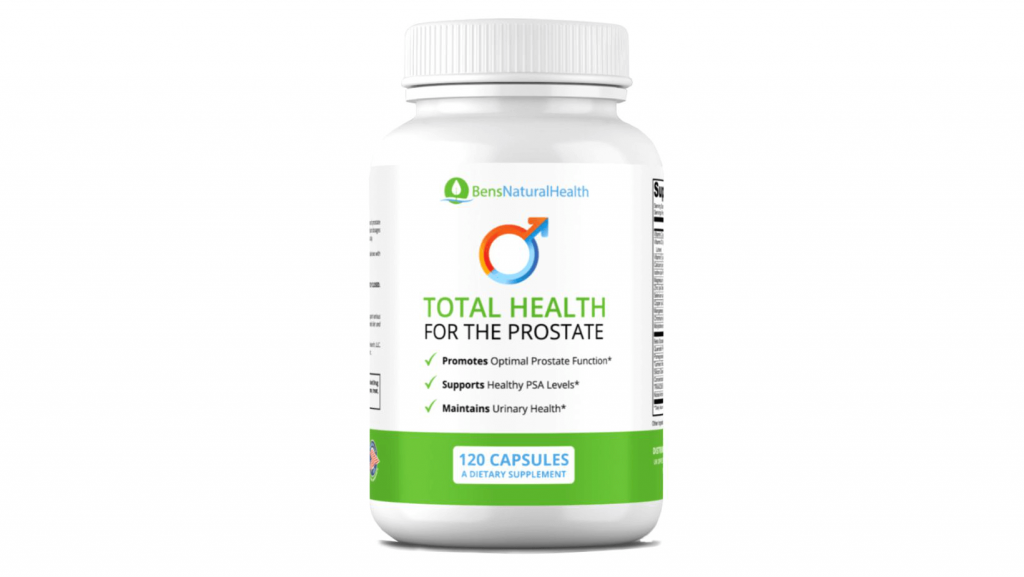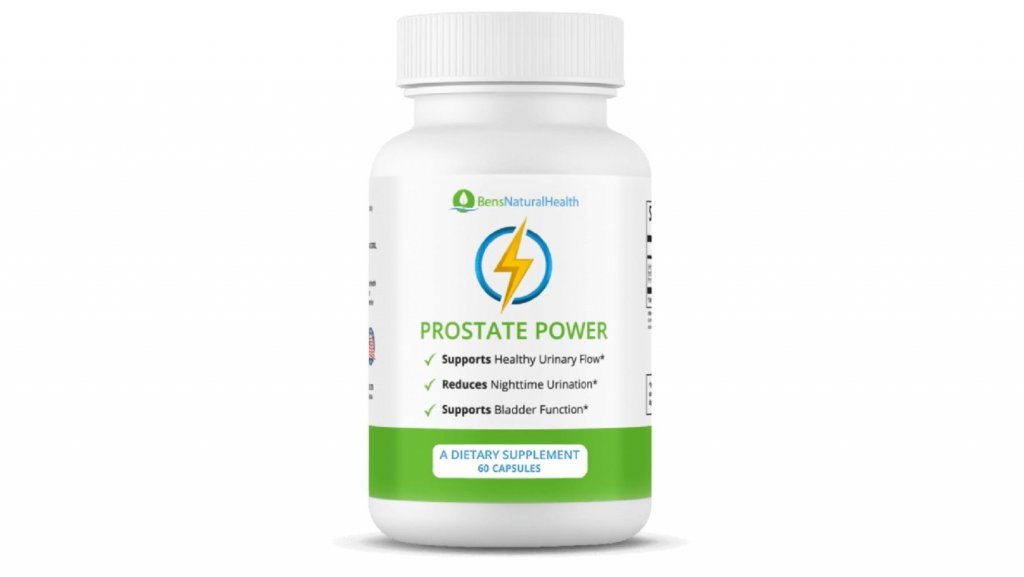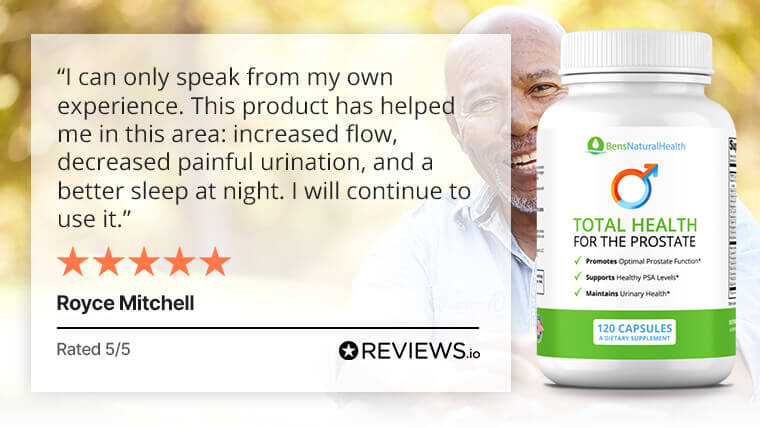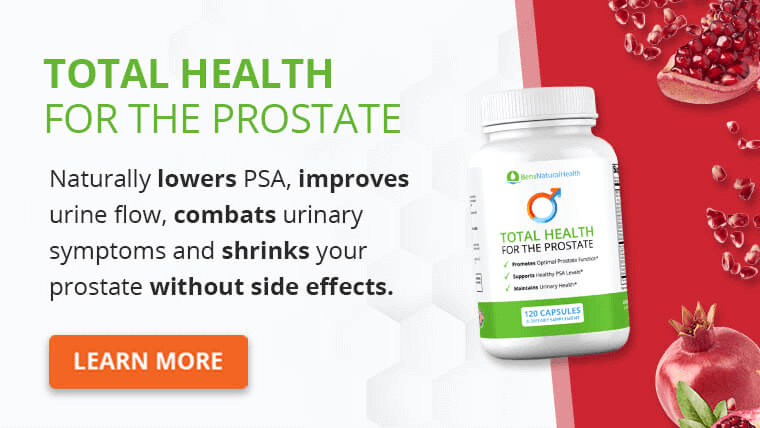Prostate problems usually remain anonymous and unknown for men before reaching 40 years old. After that age, you have many reasons to learn about prostate health.
Understanding what your prostate is and what causes enlarged prostate is paramount. It is the only way to detect urinary symptoms, solve them, and avoid further complications.
Men usually ask what causes an enlarged prostate. When this gland grows very big, they think it is due to prostate cancer. Actually, there’s a common misunderstanding that benign enlarged prostate causes cancer or erectile dysfunction (1).
Nowadays, prostate enlargement is as common as diabetes and heart disease. As such, it requires our attention even if we do not have any urinary symptoms.
Get Your FREE PSA Lowering Diet Plan!
- Naturally lower PSA levels
- Reduce nighttime trips to the bathroom
- Enjoy better bladder control and urine flow
What is an enlarged prostate?
The prostate is an essential gland in the male reproductive system. It contributes to the semen volume and synthesizes a substance that supports sperm cells.
This gland is below the urinary bladder, surrounding the urethra. In the bladder neck. Thus, as it grows, it can put pressure over the urethra or the urinary bladder. However, what is an enlarged prostate? Is it the same as prostate cancer?
An enlarged prostate is simply a gland that increased in size. It is not caused by cancer. Another medical term is benign prostatic enlargement, where benign means there’s no cancer. Another name is benign prostatic hyperplasia (BPH).
When we talk about hyperplasia, we refer to an increase in number and not size. Thus, in prostatic hyperplasia, there are more prostate cells (2). However, they remain the same size as normal prostate tissue. Such an increase in the number of cells causes an enlarged prostate. It usually starts in men after the age of 40. But they typically find out when they are near their 50s (3).
In some cases, an enlarged prostate grows evenly. In other instances, prostate growth is more irregular. When the overgrowth is near the center, it presses the urethra on the outside.
As a result, the urethra becomes narrow, compromising the urine flow. As a result, 1 out of 3 men over 50 years old report urinary symptoms. In the majority of cases, they are caused by an enlarged prostate gland (3).
Symptoms of an enlarged prostate
As mentioned above, the most common symptoms of an enlarged prostate are urination problems. It’s because the prostate portion surrounding the urethra narrows the normal passage of urine. These problems become worse as the patient gets older.
The progression prolongs which some patients may not even realize. They learn to live with the symptoms and sometimes won’t even report them. However, it is crucial to recognize the symptoms of an enlarged prostate and consult your doctor.
Here’s a list of the most important symptoms (2, 4).
The urgency to urinate
This is a sudden and unexpected urge to urinate due to an irritation of the urinary bladder.
Frequent urination
Patients report going to the bathroom several times throughout the day, sometimes with a normal urinary volume each time, and sometimes with a reduced urinary volume.
Nocturia
Urinary frequency is increased in the night, (nocturia) and patients need to wake up several times to urinate. In severe cases, it contributes to sleep problems.
Urgency incontinence
As a result of the sudden urge to urinate, some patients may even leak urine unexpectedly. This is a type of urinary incontinence.
Urinary hesitancy
A difficulty to start the urine stream.
Urinary intermittency
When the flow of urine is not continuous. Instead, patients stop and resume the urinary steam several times to empty their bladder.
Weak urinary stream
The stream of urine is weak and slow.
Straining
Patients need to push hard and force their pelvic muscles to empty the bladder fully.
Terminal dribble
When the main urinary stream finishes, patients have continuous drops of urine. They keep going for longer than usual and are sometimes followed by another urinary flow.
Post micturition dribble
After passing urine, the patient experiences an involuntary loss of urine. It is a common cause of wet pants after going to the bathroom.
A sensation of incomplete emptying of the bladder
Patients feel the bladder is not completely empty. They usually push harder and manage to continue passing urine.
Other Symptoms
Note that erection problems are not on the list, as many people believe. In some cases, patients with an enlarged prostate may experience more severe symptoms. Urinary retention is a complication of prostate enlargement that usually appears in patients who:
- Have a very large prostate
- Are aged 70 years or older
- Have a high level of PSA (Prostate-Specific Antigen)
- Have already experienced moderate to severe urinary symptoms
- Urinary retention can be either chronic or acute.
They are complications of BPH, each one with different symptoms:
Acute urinary retention
It is a medical emergency where patients are unable to pass urine. The urine flow is completely blocked, and it accumulates in the bladder, increasing its size. Acute urinary retention is very painful, appears suddenly, and needs immediate treatment.
Patients usually feel a lump or swelling in the lower portion of the abdomen. This portion becomes tender, and symptoms resolve when the bladder is emptied.
Patients with acute urinary retention may have this problem again in the future. They need treatment for BPH (benign prostatic hyperplasia). Thus, they are usually prescribed with an alpha-blocker to prevent this problem (5).
Chronic urinary retention
In these cases, patients have very severe urinary symptoms. They can still urinate but never achieve complete emptying of the bladder. The symptoms develop slowly, and sometimes patients do not realize.
Sometimes, they feel a lump or swelling in the low abdominal area. However, they do not feel any pain. Chronic urinary retention can cause a urinary infection or bladder stones. That’s why some patients see blood in the urine and require a urine test. When it is not treated, it can damage the kidneys and the urinary bladder (6).
You won’t probably have all of these symptoms at the same time. Some men have an enlarged prostate without symptoms. Also, keep in mind that many other factors can trigger the urinary symptoms above. For example, cold weather can make you feel some urinary urgency. Some medications may wake you up several times to urinate.
Moreover, urinary infections can cause a higher frequency or urinary incontinence. Thus, if you have the symptoms above, talk to your urologist to find out the cause.
In some cases, you might need a transrectal ultrasound to complete the diagnosis. Many cases are relieved with medications. Others need a prostatic urethral lift, and only a few require laser surgery or invasive surgery.
Causes of an enlarged prostate
It is challenging to trace the exact causes that trigger an enlarged prostate in a given patient.
However, we know about several risk factors associated with benign prostatic enlargement. Having one of these can increase the chance of prostate enlargement in men.
Hormones
The relationship between hormones and prostate size was postulated back in 1895. In his studies, Dr. J. William White applied bilateral castration in patients with BPH. The prostate decreased in size, and urinary symptoms improved. Thus, it was clear that androgens in men had an important role in increasing prostate size. Later on, Dr. Huggins showed that castration is effective in treating metastatic prostate cancer.
DHT
After these classic studies about prostate size and androgens, more advancements helped us understand why it happens. We now know that dihydrotestosterone (DHT) is a metabolite of testosterone. DHT triggers the differentiation of the prostate in the fetus. It is also responsible for the virilization of genitalia in men.
Later on, it contributes to other secondary sexual characteristics. In the prostate, DHT binds to the androgen receptor. After doing so, it triggers transcription genes that produce PSA protein and promote cell proliferation. Several growth factors are synthesized, and apoptosis is silenced. That’s why androgens are associated with prostate growth.
Testosterone
But there’s not always a direct correlation between serum testosterone and its effects in the prostate. That’s because the prostate has a separate microenvironment. In the prostate tissue, testosterone can be converted into DHT due to central machinery.
Thus, there’s an androgen environment inside the prostate, which can be different from the outside. That partly explains why BPH is more common in older age when testosterone levels decline. Another explanation is that androgens contribute, but they are not the only hormones involved in BPH.
Estrogen
Men have very low estrogen levels compared to women, but this hormone may be another cause of BPH. Aging men reduce their testosterone levels, but their estrogen levels remain the same.
As their estrogen to testosterone ratio increases, their risk of BPH increases as well. Studies have also identified a correlation between serum estrogens and prostate volume. Thus, it is clear that they have a role in prostate enlargement (7).
Another hormone with a key role in prostate enlargement is insulin. Recent studies suggest that high levels of insulin triggered by the diet can cause hypertension and BPH. That’s why elderly patients with prostate problems usually have high blood pressure, too (8)
Aging
As we age, a series of body changes favor prostate enlargement and lower urinary tract symptoms. Even in experimental mice, the prostate mass increases as a result of aging alone.
The proliferation of prostate tissue usually appears in the anterior and ventral portion of the prostate. However, it may also appear in the portion that surrounds the urethra. The prostate tissue multiplies, and the number of prostate ducts increases as we age. At the same time, the rate of apoptosis (programmed cellular death) is significantly reduced.
This pattern is common in the aging prostate, regardless of predisposing hormonal factors. Independent from any other cause, their prostate undergoes fibrosis and collagen deposition. As a result, the prostate lobes and the central portion start to grow.
At the microscope, they have thicker collagen bundles that accumulate over time. When such a deposition is at the midpoint of the prostatic urethra, it usually causes lower urinary tract symptoms, as described above (9).
Besides these independent factors associated with aging, we have steroid hormone changes as described above. Testosterone levels decrease, estrogen levels remain the same, and the estrogen to testosterone ratio increases.
Family History
Aging and hormonal changes are common in all men as a predisposing factor for BPH. However, there is also epidemiologic data that suggest a possible genetic predisposition as well. For example, some studies on enlarged prostate causes indicate that BPH is more common in black males.
That’s why a study published in the American Journal of Epidemiology evaluated family history and its relationship with BPH. Moreover, the study assessed the growth of the prostate and the severity of the urinary symptoms.
The authors report that most patients have a mild risk of developing severe urinary symptoms. Sometimes no risk at all. But when they have a family history of prostate enlargement, the risk increases by 1.3 times. The relationship is more robust if this relative was younger than 60 years at the moment of the diagnosis. It is also stronger for brothers with prostate enlargement as compared to fathers.
In other words, if you have brothers or a father with prostate enlargement, you’re most likely having the same thing. The symptoms are more likely to be moderate or severe, and you need to look after your prostate. That’s the only way to prevent severe symptoms and the consequences of prostate enlargement.
Interestingly, the study also showed that many men with moderate to severe prostate symptoms were ignorant or forgot about their real family history of prostate enlargement. Recalling or registering this information is very important, and may change the way your doctor addressed the problem. Thus, be sure to record this data and report it to your doctor if you’re asked about family history.
According to these studies, there’s a genetic inheritance associated with prostate enlargement. There may also be environmental factors in the family. But so far, no significant findings have confirmed the former or the latter (10).
Physical inactivity
Many studies have evaluated the effects of physical activity in the human prostate. In many cases, physical activity prevents prostate overgrowth. In other cases, it is useful to control the symptoms and improve the quality of life. Either way, physical activity appears to be beneficial.
On the contrary, physical inactivity, sedentary behavior, and obesity tend to favor BPH.
According to many studies, obese men hold a higher risk to suffer BPH symptoms and prostatitis. Others have an asymptomatic enlargement of the prostate. Regardless of the method and the definition of obesity used by the studies, all of them agree.
Obesity
Obesity is a predisposing factor for prostate enlargement, and it worsens urinary tract symptoms. An increase in waist circumference is positively associated with an increase in prostate volume. Additionally, it is associated with a higher PSA and a higher score in the IPSS.
There are many possible explanations for this association. For example, obesity increases abdominal pressure, and this increases bladder pressure, too. More adipose mass will also increase the estrogen to testosterone ratio. There’s also an increase in the activity of the sympathetic nervous system, which may worsen the urinary symptoms.
Additionally, the adipose tissue contributes to inflammation and oxidative stress. It causes microvascular problems, ischemia, and a prostatic environment that favors enlarged prostate (BPH) (11).
On the contrary, physical activity reduces the risk and the severity of symptoms in patients with BPH. For example, a recent study evaluated nocturia and its relationship with physical activity. The study showed that independent of the underlying pathology that causes nocturia; patients improve their symptoms when they are physically active.
As such, patients who are physically inactive or live a sedentary life are at risk for two reasons. One of them is a higher risk of becoming overweight or obese. These patients have a mechanical, endocrine, and inflammatory burden favoring prostate enlargement.
Secondly, they do not get the protective effects of exercise for BPH and lower urinary tract symptoms. They experience more severe symptoms and a more profound decrease in their quality of life (12).
Diet
Some studies have evaluated the epidemiology of prostate enlargement concerning dietary factors. Their authors suggest that dietary habits play a role in BPH. However, we still need more data to know the exact nutritional etiology favoring prostate enlargement.
Ethnic and geographic differences found in epidemiologic studies do not always have to do with genetics. They may respond to lifestyle and dietary habits instead.
For example, a study performed in China showed that BPH is more prevalent in the country among people who eat more animal protein and saturated fat instead of whole grains and vegetables.
In Japan, another study reported an association between BPH and consuming daily meat and regular dairy. Thus, a review of the scientific literature suggested that BPH incidence is lower in Asia due to a high-fiber, low-fat diet, which is prevalent in this area (13).
Diabetes and heart disease
As we grow older, the risk of metabolic problems and prostate enlargement increases. However, studies suggest a more direct association between diabetes and BPH.
Patients with diabetes and an enlarged prostate have a higher chance of developing severe symptoms. This is maybe because both conditions cause urinary symptoms that overlap.
However, other studies show that diabetes patients have a higher median growth of the prostate gland. The association is not very clear, but it seems evident now there is a link between BPH and insulin.
Additionally, consider that type 2 diabetes can promote BPH through vascular disorders affecting the prostate. In a model of experimental hypoxia, researchers found that abnormal blood flow can stimulate prostate growth. This tissue responds to hypoxia by secreting growth factors to promote angiogenesis (13).
Other vascular problems are positively associated with prostate health, too—for example, ischemic heart disease. According to studies, the frequency of coronary artery disease is higher in men with prostate enlargement. Moreover, researchers suggest that these conditions are closely related to one another.
The association still remains elusive, but it is apparently explained by atherosclerosis, which causes an abnormal flow pattern and hypoxia in the prostate. This pathologic condition triggers the release of growth factors and causes an enlarged prostate (13).
Natural Supplements for An Enlarged Prostate
At Ben’s Natural Health, we have formulated natural supplements to improve prostate health and reduce prostate size. When it comes to managing your BPH, we firmly believe that natural is the way to go. Not only will natural remedies help to heal your prostate, relieving you of uncomfortable symptoms, but they will do so without any adverse side effects.
Total Health

Total Health contains ingredients clinically proven to reduce prostate size, combat BPH symptoms and help you to restore optimal prostate health.
Clinical trials and meta-studies show that the active ingredients in Total Health have a positive impact on prostate volume, improve lower urinary tract symptoms, increase peak urinary flow and decrease the risk of acute urinary retention.
Prostate Power

Our other dietary supplement, Prostate Power, contains ingredients clinically proven to shrink an enlarged prostate and slow the progress of BPH and prostate disease.
The key active ingredients in Prostate Power have been shown in numerous clinical trials and meta-studies to reduce prostate volume, improve urine flow and decrease the risk of acute urinary retention.
Why Choose Ben’s Natural Health Supplements?
At Ben’s Natural Health, our motto is to combine holistic healing with modern science.
Ben’s Natural Health is the world’s first high-quality, all-natural, scientifically proven clinical supplement company. Our supplements are effective, natural and 100% side effect free.
Moreover, at Ben’s Natural Health, we have four rules for all our supplements:
- We only use the highest quality ingredients
- We only use them if they have been proven to work in independent, peer-reviewed double-blind studies
- With all our supplements, we find a way to get every ingredient into a single bottle
- We always formulate them in clinically significant doses of the most bioavailable form
We pride ourselves on offering excellent customer service. We offer a free health consultation where you can ask questions and receive tailored advice from our expert health consultants.
Conclusion
An enlarged prostate is not the same as prostate cancer but causes similar symptoms. Patients with lower urinary tract symptoms should check their prostate after reaching 40 years.
After this age, prostate enlargement becomes more prevalent. That’s especially the case if we have other predisposing factors, such as obesity and sedentary behavior.
Hormones play a significant role in the development of BPH, as well as family history. It is also essential to look after your diet, trying to increase your intake of fruits and vegetables.
There’s an additional protective effect from physical activity, which may also reduce the incidence of diabetes and heart disease; all of them conditions strongly related to a high incidence of prostate issues.
Next Up










